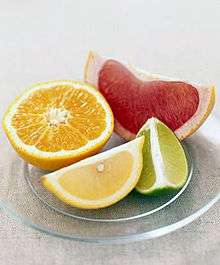Hesperidium

A hesperidium (plural hesperidia) is a modified berry with a tough, leathery rind.
The peel contains volatile oil glands in pits. The fleshy interior is composed of separate sections, called carpels, filled with fluid-filled vesicles that are actually specialized hair cells.
The outer ovary wall becomes the thick spongy layer of the rind, while the inner ovary wall becomes very juicy with several seeds.
Oranges and other citrus fruits are common examples in cultivation.
Unlike most other berries, the rind of cultivated hesperidia is generally not eaten with the fruit because it is tough and bitter. A common exception is the kumquat, which is consumed entirely.
The outermost, pigmented layer of rind contains essential oils and is known as the flavedo. When scraped off and used as a culinary ingredient it is called zest. A confection called succade can also be produced by candying the inner rind (known as pith or albedo) of the citron or lemon.
Linnaeus gave the name Hesperideæ to an order containing the genus Citrus, in allusion to the golden apples of the Hesperides.
See also
References
- Bailey, L. H.; Bailey, E. Z. (1976). Hortus (Third ed.). New York: Macmillan. p. 275. ISBN 0-02-505470-8.
External links
| Wikimedia Commons has media related to Hesperidium. |
 The dictionary definition of hesperidium at Wiktionary
The dictionary definition of hesperidium at Wiktionary